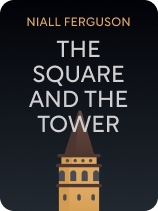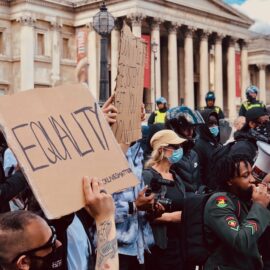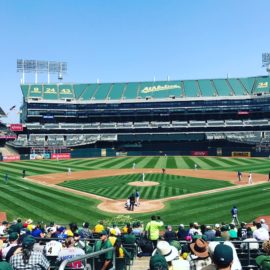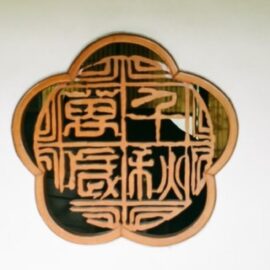

This article is an excerpt from the Shortform book guide to "The Square and the Tower" by Niall Ferguson. Shortform has the world's best summaries and analyses of books you should be reading.
Like this article? Sign up for a free trial here.
What if you apply network theory to history? How do societal hierarchies impact war and peace?
Historians typically focus on the history of governments and other institutions that are organized as formal hierarchies. The Square and the Tower by Niall Ferguson shows that other types of networks also affect society. He sets out to show how such alternate networks have affected the world.
Continue reading for an overview of this book that helps us see the past in a new way.
Overview of The Square and the Tower by Niall Ferguson
The Square and the Tower by Niall Ferguson applies network theory—the study of how people and other entities connect with each other—to the study of world history. The title of the book is a metaphor for the interplay between formal hierarchies and other types of networks: The tower represents governmental authority and formal hierarchies, while the town square represents social and commercial networks outside the governmental hierarchy.
Ferguson—a best-selling author and Stanford University historian—spends most of the book describing social, commercial, and other networks that existed at various times in history as well as looking at the evolution of governments. In the final section of the book, he turns his attention to the future, discussing how the growth of global networks of e-commerce and social media might affect the balance of power in the world.
We’ll explain the basics of network theory before diving into the key principles in Ferguson’s discussion of history. We’ll conclude by considering his perspective on the future, which is based on these principles.
Network Theory
Network theory is the study of how people or other entities connect and interact with each other to form networks. It examines how different kinds of networks operate and how they affect the world around them.
As Ferguson explains, networks can take many forms, because different types of entities can connect in many different ways. You can have a network of computers connected via digital communication protocols. You can have a network of businesses connected by supply chains and cash flows. And, you can have a network of people connected by shared interests, family ties, or other bonds of loyalty.
Ferguson observes that humans seem to have an innate proclivity for connecting with each other and forming networks. This has led to the creation of governments, social clubs, and all the other interpersonal networks that collectively make up human society.
Classifying Networks
Ferguson discusses how networks can be categorized based on their structure. In most networks, some entities are more important or powerful than others. If you know the structure of a network, that is, which entities are connected to each other, you can infer the importance of any given entity in the network based on its “centrality.”
Centrality has three components:
- Degree: The number of other entities that a given entity is directly connected to. For example, if Airport A is directly connected to 15 other airports, it has a higher degree of centrality than Airport B, which is directly connected to only four other airports.
- Closeness: The average number of steps you must take to get from the entity in question to each of the other entities on the network. If a traveler from Airport A can reach all other airports in an average of three connecting trips, but a traveler from Airport B must make five connections on average to reach the other airports, Airport A has more closeness.
- Betweenness: The amount of information that passes through a particular entity as it flows through the network. If more travelers connect to other destinations through Airport C than through Airport D (because, say, it serves as an international port of entry), then Airport C has more betweenness.
Hierarchies as Networks
According to Ferguson, a hierarchy is a specific kind of network in which one entity exercises authority over others, who in turn exercise authority over others, and so on, without any other connections of authority or loyalty. This means that the first entity automatically has the most betweenness because all information flows up from every lower entity, passes through the person at the top, and only then is distributed elsewhere. The importance of individual entities diminishes as you go down the tiers of the hierarchy because each entity is connected only to its own subordinates and its lone superior.
Three Principles of Hierarchies
As he applies network theory to his analysis of world history, Ferguson makes three key observations: Hierarchies are necessary to maintain social order, additional networks tend to undermine hierarchies, and hierarchies can deal with a only limited amount of complexity.
Hierarchies Maintain Order
Ferguson observes that many important networks, such as governments and corporations, are at least approximately hierarchical in their structure. He suggests that these networks tend to take the form of hierarchies because hierarchies are particularly efficient when it comes to coordinating activities and resolving disputes. He explains that hierarchies facilitate dispute resolution because any two entities that disagree can appeal to their shared superior. But, if they don’t have anyone that they both regard as superior, then their differences continue to fester—sometimes until they go to war and the victor emerges as the superior in a new hierarchy.
For this reason, Ferguson goes so far as to say that peace and social order are possible only when there’s a clear hierarchy that everyone accepts as legitimate. In most cases, a government is the hierarchy that maintains order. But, sometimes, alternative entities establish the hierarchy. For example, international treaties often have the effect of creating a hierarchy of national powers: The treaty itself acts as a moderator between nations by establishing agreements and relationships between them, as well as provisions for enforcement, yet without creating an international government, per se.
The World Hierarchy Throughout History
As evidence that hierarchies are necessary for peace, Ferguson outlines how world hierarchies have changed over the course of history, and he correlates periods of relative peace to times when there was a clear hierarchy and periods of widespread violence to times when there wasn’t.
For example, when the Protestant Reformation of the 1500s undermined people’s faith in the religious and political hierarchy of the Catholic Church, the result was widespread religious conflict and civil war throughout Europe. Similarly, in the 1700s, France went through a series of revolutions. One group after another succeeded in overthrowing a French government that people didn’t perceive as legitimate, only to set up another government that wasn’t widely recognized as legitimate.
In the 1800s, by contrast, Europe enjoyed relative peace under the “pentarchy,” a hierarchy of European nations established by international treaties. Great Britain played the role of “Chief Balancing Power” at the top of the hierarchy, with France, Prussia, Austria, and Russia making up the remainder of the pentarchy and other nations occupying lower tiers in the hierarchy.
But, by the early 1900s, the pentarchy no longer reflected reality. The unification of Germany, changes to the European network of treaties, advances in military and industrial technology, and the growth of some European powers’ colonial empires had changed the balance of power, but it wasn’t clear what the new hierarchy was. In Ferguson’s view, the First World War was the inevitable result of this lack of a clear hierarchy. This is because disagreements between nations are inevitable, and without a mutually respected moderator to resolve them, sooner or later the conflicts will escalate.
After the Second World War, a new global hierarchy emerged. The United States became the main world power and was joined by Russia, China, France, and the UK on the UN Security Council. Ferguson sees the Security Council as a new pentarchy under which other nations in the UN make up the next tier of the global hierarchy. This new hierarchy facilitated a period of relative peace in the Western Hemisphere (the Cold War never turned into an all-out war) that has lasted until the present.
Additional Networks Undermine Hierarchies
Ferguson’s second conclusion is that any other network that creates additional connections of loyalty between entities within a hierarchy weakens the power of the hierarchy. This is because the additional connections reduce the betweenness of the entities in the tiers above them so that the higher-up entities no longer are the sole pass-through points for information. Any network that allows people to share ideas outside of official communications has the potential to spread ideas that are contrary to the hierarchical order, even if that’s not the network’s primary purpose.
And the more loyalties people have (to friends, ideologies, and so on) outside the official hierarchy, the less complete their loyalty to the hierarchy becomes. Thus, according to Ferguson, there is usually some amount of tension between formal hierarchies and other networks.
Totalitarian Hierarchies Isolate People
Ferguson recounts that the tension between hierarchies and other networks is most evident in totalitarian states, such as Nazi Germany, the Soviet Union, and Communist China. In these regimes, the government hierarchy attempted to control every aspect of life and thus tried to isolate individuals from all other networks.
The government hierarchies in these states controlled people primarily through fear, using brutality and surveillance to instill in everyone the fear of being punished for the mere suspicion of conspiring against the government. This fear of raising suspicion prompted people to avoid having any contact with each other outside official channels. Ironically, the higher up in the government hierarchy you were, the more likely you’d be suspected because you’d be more valuable to a conspiracy if there was one.
Conspiracy Theories Don’t Work
The tension between hierarchies and other networks also implies that most conspiracy theories are wrong. In Ferguson’s experience, the most common conspiracy theories allege that there’s a secret conspiracy controlling some official hierarchy from behind the scenes. But in reality, conspiracies between individuals or groups within a hierarchy tend to undermine those hierarchies, not absorb them. Based on historical precedent, it’s not unusual for a conspiracy to overthrow a hierarchy, but it’s extremely unusual for a conspiracy to surreptitiously control one.
Hierarchies Struggle With Complexity
Finally, Ferguson notes that although hierarchies are efficient for resolving disagreements and maintaining order, they are inefficient when it comes to developing creative solutions to complex problems. This is because decisions tend to be made in the upper tiers of the hierarchy. In an extreme case where all the decisions are made by a single person at the top, the system could never adapt to any situation that was too complex for that single person to fully comprehend.
Though hierarchies where one person makes all decisions are rare, Ferguson observes that hierarchies in general are notoriously inflexible, even ones whose lower tiers have some decision-making authority. At best, they take longer to react to changing situations than networks in which authority is more diffuse and individuals function more autonomously. At worst, they’re completely incapable of adapting to complex situations. This is why some networks, such as the economy as a whole, cannot effectively adopt a hierarchical structure.
This observation also explains why guerilla warfare sometimes enables small, relatively disorganized bands of insurgents to defy much larger hierarchically organized military powers: In the chaotic environment of guerilla warfare, a formless network of small, autonomous bands operates more efficiently than a traditional organized military.
The Prognosis for the Future
As Ferguson recounts, certain visionaries, social media proponents, and Silicon Valley entrepreneurs have argued that making the world more connected through social media and global commerce will contribute to building a utopian future of world peace and equality. Ferguson contends that this is not the case. He stops short of making specific predictions about what the future does hold, but he identifies a number of trends contradicting the idea that the growth of current networks will precipitate world peace and equality.
Network Growth Doesn’t Bring Peace
First of all, the growth of networks independent of a hierarchical power structure tends to weaken that power structure. Thus, Ferguson says, if the growth of new networks sufficiently undermines the hierarchies that are responsible for maintaining order, the result is anarchy, not peace.
In the case of social media, this scenario is not entirely hypothetical. As Ferguson points out, the proliferation of “fake news” and other inflammatory information passed around social media networks has increased the polarization of opinions and created some unrest in the United States.
Furthermore, says Ferguson, Islamic insurgent groups such as ISIS have made effective use of social media and messaging apps to grow their networks and coordinate their activities. This growth of insurgent networks in the Middle East led to extensive violence and the overthrow, or partial overthrow, of government hierarchies in Iraq and Syria.
The Global Hierarchy of the Future Is Uncertain
Another reason Ferguson doesn’t expect the growth of extra-governmental networks to lead to peace is that they threaten the existing established hierarchy. Ferguson believes that it takes a universally accepted hierarchy to maintain order and stability in society. He’s concerned that the world hierarchy established after World War II has decayed, much as the old pentarchy did before World War I, and that there isn’t a unified global vision for what the world hierarchy looks like, or should look like, going forward.
One reason for this breakdown is the rise of online commerce and communications networks such as Facebook, Google, and Amazon, which have emerged as powerful entities. It’s unclear exactly how these platforms will fit (or should fit) into the hierarchy of the global power structure. The only certainty is that they will, in some way, be solidly a part of it: The elections of 2016—both in the US and in the UK—showed decisively how social media can influence democratic governments by influencing voters.
Ferguson examines two contrasting approaches some governments are taking to regulating social media platforms as they try to incorporate them into their existing power structures. One approach hails from Europe and the other from China.
The European Vision
While the US government has left social media networks largely to their own devices, European governments have increasingly tried to regulate them. European regulators demand that social media companies promptly remove and report any posts that call for violence or otherwise violate the law. However, they have allowed social media companies to remain otherwise independent.
Ferguson notes that in some ways, this regulatory relationship between governments and social media platforms makes the platforms even more powerful: The government depends on them to enforce its own laws online, but the platforms are also free to censor whatever opinions or information they please (unlike most democratic governments). That said, Ferguson also suggests that social media platforms may not be able to censor content effectively because they have so many users and relatively few employees.
The Chinese Vision
China, by contrast, has largely blocked access to Western social media sites, instead setting up its own platforms over which the government has complete control. Ferguson notes that China’s social media, web search, and e-commerce platforms are now comparable to Facebook, Google, and Amazon in terms of their usership and revenue. And, because of their broad usership, they’ve become powerful tools that help the Chinese government keep its citizens under surveillance.

———End of Preview———
Like what you just read? Read the rest of the world's best book summary and analysis of Niall Ferguson's "The Square and the Tower" at Shortform.
Here's what you'll find in our full The Square and the Tower summary:
- Why conspiracy theories are often wrong
- Why social media networks stir up more conflict than harmony
- How social networks undermine hierarchies and social order






